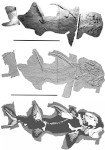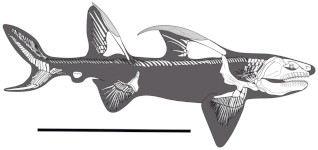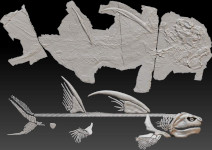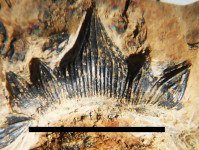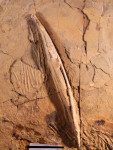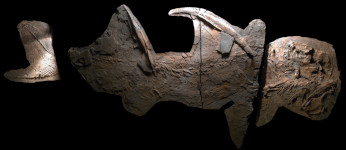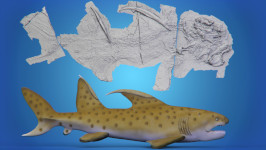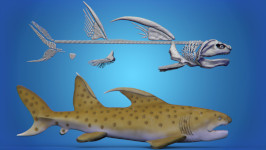Dracopristis hoffmanorum
Hodnett, Grogan, Lund, Lucas, Suazo, Elliott & Pruitt, 2021
Classification: Elasmobranchii Ctenacanthiformes incert. fam.
Reference of the original description
Ctenacanthiform sharks from the Late Pennsylvanian (Missourian) Tinajas Member of the Atrasado Formation, Central New Mexico. New Mexico Museum of Natural History and Science, Bulletin, 84, 391–424
Ctenacanthiform sharks from the Late Pennsylvanian (Missourian) Tinajas Member of the Atrasado Formation, Central New Mexico. New Mexico Museum of Natural History and Science, Bulletin, 84, 391–424
Description:
Citation: Dracopristis hoffmanorum Hodnett, Grogan, Lund, Lucas, Suazo, Elliott & Pruitt, 2021: In: Database of fossil elasmobranch teeth www.shark-references.com, World Wide Web electronic publication, Version 01/2026
Please send your images of "Dracopristis hoffmanorum" to info@shark-references.com

Dracopristis hoffmanorum Hodnett, Grogan, Lund, Lucas, Suazo, Elliott & Pruitt, 2021, NMMNH P-68537, holotype, scale bars equal 1 meter © JOHN-PAUL M. HODNETT

Dracopristis hoffmanorum Hodnett, Grogan, Lund, Lucas, Suazo, Elliott & Pruitt, 2021, NMMNH P-68537, holotype, scale bars equal 1 meter © JOHN-PAUL M. HODNETT
Distribution Geographic
Kinney Brick Quarry, Bernalillo County, New Mexico
Kinney Brick Quarry, Bernalillo County, New Mexico
Distribution Stratigraphy
Tinajas Member, Atrasado Formation, Upper Pennsylvanian (Missourian)
Tinajas Member, Atrasado Formation, Upper Pennsylvanian (Missourian)
Material
only holotype
only holotype
Description
Original diagnosis after Hodnett et al. (2021) p. 394 [29609]: A medium-size ctenacanthiform shark with an estimated body length of 206 cm. Body form craniocaudally elongated and dorsoventrally narrow. Dentition is cladodont with all cusps triangular in shape with v-shaped cristae, median cusp relatively tall, lateral cusps are half the height of the median cusp, a single intermediate cusps positioned just forward of the median cusp, moderately developed basolabial depression, and orolingual and basolabial projections are two separate elliptical buttons. Neurocranium mediolaterally broad, postorbital process anteroposteriorly broad, posterior margin of the dorsal otic ridge is chisel shaped, a laterally projecting process present on lateral otic ridge, and no median crest on occipital. Palatoquadrates with a moderately developed anterodorsal process on otic process, otic process dorsoventrally deep, and palatine ramus short. Meckel’s cartilage with pointed, moderately developed retroarticular process, and relatively dorsoventrally deep and anteroposteriorly short dental ramus. Hyomandibula dorsoventrally expanded anteriorly. Five branchial arches present, the largest anterior and the remainder decreasing in size posteriorly. Pharyngobranchials thin, blade-like laminae that taper posteriorly with anterior y-shaped articulations. Each dorsal fin spine supported with large basal plates and fin radials. Dorsal spines ornamented with lateral, longitudinal costae bearing elliptical to rounded denticles and a single smooth anterior costa with small transverse ridges. First dorsal spine is 57 cm, 27% of the total body length and recurving posteriorly over body. First and second dorsal fin ceratotrichia connected to dorsal spines. Anal fin present, internally supported by a single fused plate. Caudal fin internally heterocercal, of the plesodic style. Hypochordal lobe principally supported by proximal and distal radials, the latter, associated with proximal radials 2-8, taper distally to a point, grade in size from the first to the third distal, which is largest in size and recurved posterocaudally. Subsequent distal radials 4-6 decline in size thereafter. Proximal caudal radials articulate with haemal arches and spines. Epichordal lobe at a near right angle. Scapulocoracoids form an anteriorly directed narrow process. Scapular blade margin expanded posteriorly from dorsal apex to caudally rounded margin before narrowing and expanding into a concave ridge. More ventrally, this narrows to a posteriorly directed glenoid process. Pectoral fin with tribasal articulation and aplesodic endoskeletal fin. A secondary trapezoidal cartilage present in pectoral fin, articulating on ventral margin of mesopterygium and anterior margin of metapterygium. Pelvic girdle triangular and bearing series of proximal fin radials; metapterygium or metapterygial axis not evident.
Original diagnosis after Hodnett et al. (2021) p. 394 [29609]: A medium-size ctenacanthiform shark with an estimated body length of 206 cm. Body form craniocaudally elongated and dorsoventrally narrow. Dentition is cladodont with all cusps triangular in shape with v-shaped cristae, median cusp relatively tall, lateral cusps are half the height of the median cusp, a single intermediate cusps positioned just forward of the median cusp, moderately developed basolabial depression, and orolingual and basolabial projections are two separate elliptical buttons. Neurocranium mediolaterally broad, postorbital process anteroposteriorly broad, posterior margin of the dorsal otic ridge is chisel shaped, a laterally projecting process present on lateral otic ridge, and no median crest on occipital. Palatoquadrates with a moderately developed anterodorsal process on otic process, otic process dorsoventrally deep, and palatine ramus short. Meckel’s cartilage with pointed, moderately developed retroarticular process, and relatively dorsoventrally deep and anteroposteriorly short dental ramus. Hyomandibula dorsoventrally expanded anteriorly. Five branchial arches present, the largest anterior and the remainder decreasing in size posteriorly. Pharyngobranchials thin, blade-like laminae that taper posteriorly with anterior y-shaped articulations. Each dorsal fin spine supported with large basal plates and fin radials. Dorsal spines ornamented with lateral, longitudinal costae bearing elliptical to rounded denticles and a single smooth anterior costa with small transverse ridges. First dorsal spine is 57 cm, 27% of the total body length and recurving posteriorly over body. First and second dorsal fin ceratotrichia connected to dorsal spines. Anal fin present, internally supported by a single fused plate. Caudal fin internally heterocercal, of the plesodic style. Hypochordal lobe principally supported by proximal and distal radials, the latter, associated with proximal radials 2-8, taper distally to a point, grade in size from the first to the third distal, which is largest in size and recurved posterocaudally. Subsequent distal radials 4-6 decline in size thereafter. Proximal caudal radials articulate with haemal arches and spines. Epichordal lobe at a near right angle. Scapulocoracoids form an anteriorly directed narrow process. Scapular blade margin expanded posteriorly from dorsal apex to caudally rounded margin before narrowing and expanding into a concave ridge. More ventrally, this narrows to a posteriorly directed glenoid process. Pectoral fin with tribasal articulation and aplesodic endoskeletal fin. A secondary trapezoidal cartilage present in pectoral fin, articulating on ventral margin of mesopterygium and anterior margin of metapterygium. Pelvic girdle triangular and bearing series of proximal fin radials; metapterygium or metapterygial axis not evident.
Remarks
shark-references Species-ID=16131;
type species of Dracopristis Hodnett et al., 2021 p. 394 [29609] by original designation (Art. 68.2 ICZN); valid after Hodnett et al. (2021) p. 394 [29609]; Hodnett & Lucas (2021) p. 361 [29610]
shark-references Species-ID=16131;
type species of Dracopristis Hodnett et al., 2021 p. 394 [29609] by original designation (Art. 68.2 ICZN); valid after Hodnett et al. (2021) p. 394 [29609]; Hodnett & Lucas (2021) p. 361 [29610]
References
Rise and diversification of chondrichthyans in the Paleozoic. Paleobiology, 50(2), 271–284
DOI: 10.1017/pab.2024.1

Review of the Late Pennsylvanian Fish Assemblage from the Kinney Brick Quarry, New Mexico. New Mexico Museum of Natural History and Science, Bulletin, 84, 359–390

Ctenacanthiform sharks from the Late Pennsylvanian (Missourian) Tinajas Member of the Atrasado Formation, Central New Mexico. New Mexico Museum of Natural History and Science, Bulletin, 84, 391–424
Rise and diversification of chondrichthyans in the Paleozoic. Paleobiology, 50(2), 271–284
DOI: 10.1017/pab.2024.1

Review of the Late Pennsylvanian Fish Assemblage from the Kinney Brick Quarry, New Mexico. New Mexico Museum of Natural History and Science, Bulletin, 84, 359–390

Ctenacanthiform sharks from the Late Pennsylvanian (Missourian) Tinajas Member of the Atrasado Formation, Central New Mexico. New Mexico Museum of Natural History and Science, Bulletin, 84, 391–424








